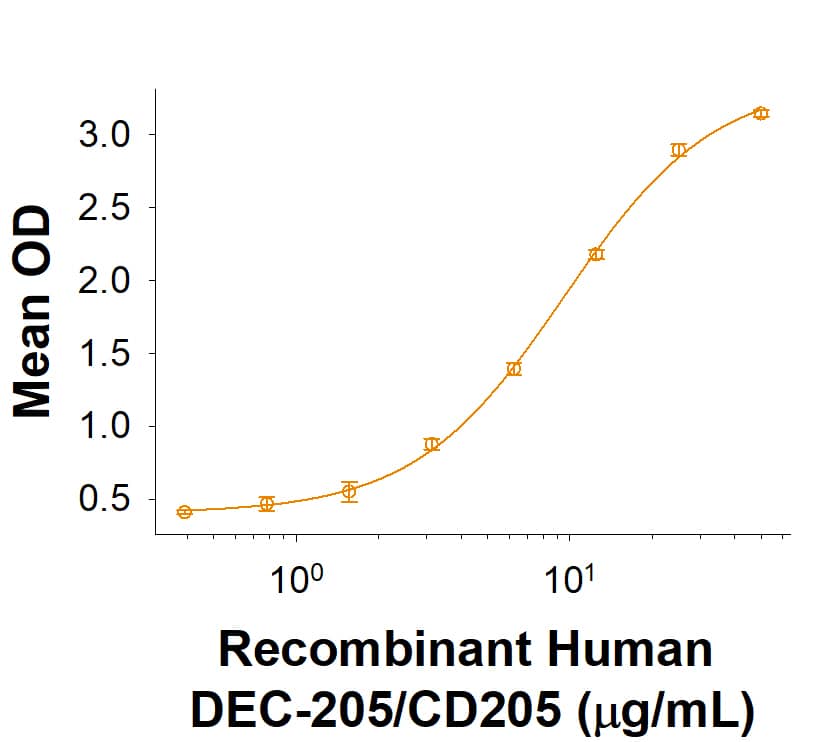Recombinant Human DEC-205/CD205 Fc Chimera Protein, CF
R&D Systems, part of Bio-Techne | Catalog # 10205-DE

Key Product Details
Source
HEK293
Accession #
Structure / Form
Disulfide-linked homodimer
Conjugate
Unconjugated
Applications
Bioactivity
Product Specifications
Source
Human embryonic kidney cell, HEK293-derived human DEC-205/CD205 protein
| Human DEC-205/CD205 (Ser28-Asp1666) Accession # O060449.3 |
IEGRMD | Human IgG1 (Pro100-Lys330) |
| N-terminus | C-terminus |
Purity
>95%, by SDS-PAGE visualized with Silver Staining and quantitative densitometry by Coomassie® Blue Staining.
Endotoxin Level
<0.10 EU per 1 μg of the protein by the LAL method.
N-terminal Sequence Analysis
Ser28
Predicted Molecular Mass
215 kDa
SDS-PAGE
200-250 kDa, under reducing conditions
Activity
Measured by its binding ability in a functional ELISA.
When Recombinant Human CD302/CLEC13A Fc Chimera (Catalog # 10203-CL) is immobilized at 5 µg/mL (100 µL/well), Recombinant Human DEC-205/CD205 Fc Chimera (Catalog # 10205-DE) binds with an ED50 of 4-28 μg/mL.
When Recombinant Human CD302/CLEC13A Fc Chimera (Catalog # 10203-CL) is immobilized at 5 µg/mL (100 µL/well), Recombinant Human DEC-205/CD205 Fc Chimera (Catalog # 10205-DE) binds with an ED50 of 4-28 μg/mL.
Scientific Data Images for Recombinant Human DEC-205/CD205 Fc Chimera Protein, CF
When Recombinant CD302/CLEC13A Fc Chimera (10203-CL) is immobilized at 5 µg/mL, 100 µL/well, Recombinant Human DEC-205/CD205 Fc Chimera (Catalog # 10205-DE) binds with an ED50 of 4-28 µg/mL.
Formulation, Preparation and Storage
10205-DE
| Formulation | Lyophilized from a 0.2 μm filtered solution in PBS with Trehalose. |
| Reconstitution | Reconstitute at 500 μg/mL in PBS. |
| Shipping | The product is shipped at ambient temperature. Upon receipt, store it immediately at the temperature recommended below. |
| Stability & Storage | Use a manual defrost freezer and avoid repeated freeze-thaw cycles.
|
Background: DEC-205/CD205
References
- Butler, M. et al. (2007) Immunology. 120:362.
- Jiang, W. et al. (1995) Nature. 375:151.
- Bonifaz, L. et al. (2002) Jour. Exp. Med. 196:1627.
- Shrimpton, R. et al. (2009) Mol. Immunol. 46:1229.
- Lahoud MH. et al. (2018) Proc Natl Acad Sci U.S.A. 109:16270.
- Hou X. et al. (2017) Cell Mol Immunol. 14:675.
- Cao L. et al. (2016) Proc Natl Acad Sci U.S.A. 113:13438.
- Hawiger D. et al. (2001) J Exp Med. 194:769.
- Kita M. et al. (2018) Oncotarget. 9:15828.
- Kato, M. et al. (2003) J Biol Chem. 278:34035.
- Butler M. et al. (2017) J. Immunol. 120:362.
- Niezold T. et al. (2015) Immunology. 145:519.
Alternate Names
CD205, DEC205, Ly75
Gene Symbol
LY75
UniProt
Additional DEC-205/CD205 Products
Product Documents for Recombinant Human DEC-205/CD205 Fc Chimera Protein, CF
Product Specific Notices for Recombinant Human DEC-205/CD205 Fc Chimera Protein, CF
For research use only
